|
FAQs about Stony Coral, Cnidarian
Identification 11
Related FAQs: Stony Coral ID 1, Stony Coral ID 2, Stony Coral ID
3, Stony
Coral ID 4, Stony Coral ID 5,
Stony Coral ID 6, Stony Coral ID 7, Stony Coral ID 8, Stony Coral ID 9, Stony Coral ID 10, Stony Coral ID 12, Stony Coral ID 13, Stony Coral ID 14, Stony Coral ID 15, & Cnidarian
Identification, Stony FAQs 1, Stony
FAQs 2, Foods/Feeding/Nutrition, Disease/Health, Propagation, Coral Compatibility, Stony Coral Behavior,
Related Articles: Stony
Corals,
|
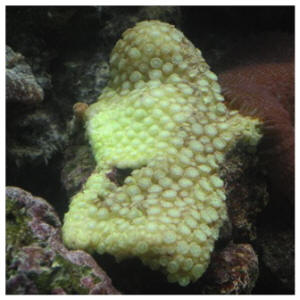 |
|
Scleractinian ID 3/10/10
Hi Crew!
<Ross>
I have been lurking on WWM for a time now in an attempt to
identify a stony coral that was hidden in my tank. It was
obscured by a large rock that I recently traded to the LFS for a
T. peltata specimen. This coral apparently hitchhiked into my
tank about 14 months ago on some live rock that was aquacultured
in Florida (according to the LFS; but it had Arca zebra on some
rocks, so probably is correct) .
<A good clue>
The corallites are about 5mm diameter
<And this>
and the polyps are extended most of the time (please see the
attached picture - between the duster and the snail ).
Interestingly, the polyps facing upward appear to be dead,
whereas the ones facing horizontally, or downward, appear to be
fine. This coral is, and has been, about 24in below the lights
under about 19 in of water.
My hope is that this is a zooxanthellate coral,
<Is, though not very "pretty" because of,
eh?>
but I thought I would get a second opinion. It is a very nice
addition to my tank and I would like to keep it healthy.
So far, my guesses are (in order of likelihood):
Montastrea annularis
Tubastrea spp.
Favia fagrum
<... Is a Faviid... likely a Montastrea... probably
annularis>
Tank parameters: T = 78-81F, NH3 = 0, N02 = 0, N03 = trace, pH =
7.95-8.20, Ca = 420mg/l, Alk = 8dKH, Mg = 1300mg/l. 72 gal
bowfront, Aqua C Remora, Fluval 305 w/Chemi-Pure . 10gal weekly
water change with aged RO/DI and Oceanic salt mix. 2x150W HQI,
2x96W T5.
Thank you for your hard work on WWM! It is great to have a
resource to dispel much of the misleading advice and bad science
circulating in the hobby.
Ross
<Thank you for your kind, encouraging words, and sending along
this ID note. Enjoy! Bob Fenner>
|
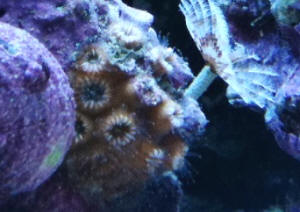 |
|
Tricky ID question -- 12/14/09
Hi Crew,
I've been trying to get a ID on this little hitchhiker little
over a week now without any success so I'm turning to you as
my last chance. Instead of mailing photos I'm just linking
them from a local forum where I tried to get an ID first.
http://www.saltvattensguiden.se/forumet/attachment.php?attachmentid=40687&d=1260203100
http://www.saltvattensguiden.se/forumet/attachment.php?attachmentid=40852&d=1260636838
The story is that after moving a piece of rock slightly I found
these 2 polyps and my first thought was that I had found 2 Majano
anemones
<Mmm, no>
but as I have never had Majano before I asked about them in a
forum before removing them and some of the other members thought
I should leave them for now as they didn't think they looked
like Majano.
<Good>
I decided to leave them and turn the stone around so I could see
them every time I went past the aquarium. When I turned the stone
around I saw that they wasn't attached to stone but rather
growing as a part of the stone.
<Yes. In both pics you can see a skeleton from what is likely
another specimen>
In the second picture you can see remains of a dead polyp that I
think is of the same type as the two living (I base that on
studying the base of the polyp at night when it's retracted
and comparing it to the base of the dead polyps).
<Yes>
Below the polyps in the second picture is another 5 remains of
dead polyps that tells me it seems to grow in a branching
way.
<Mmm, maybe. I suspect this is a solitary polyp
species>
I don't think it's an anemone anymore and I'm
guessing at some kind of LPS but I really have no clue so I'm
looking for all help I can get on identifying this so I can give
it the best possible place in my tank or if it's bad remove
it before it gets bigger.
Thanks in advance & best regards,
Tony
<There are a few Scleractinian (stony coral) families that
this might be.
See the Net, WWM re: Perhaps peruse here:
http://wetwebmedia.com/dendroidfaqs.htm
see the pix about midway down... and the families Rhizangiidae,
Oculinidae.
Bob Fenner>
|
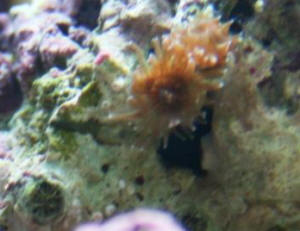 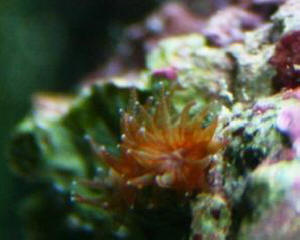 |
|
SV: Tricky ID question, Cnid., Scler.
f's -- 12/14/09
Thanks for the link, the pictures half way down does look a bit
like the once I have, mine is just much more brown. I have also
found some pictures of Galaxea that looks a bit like the one I
have but I think I'll have to wait with a better ID until it
grows bigger/gets more polyps.
<Mmm, color can/does change with local conditions, mainly
light factors and foods... The physical aspects of corallites is
most useful for identification>
This far I have a feeling it's a "day-active" coral
filled with Zooxanthellae as it completely deflates within 60
minutes after lights go out and it only starts inflating again
when I turn lights on in the morning.
<This behavior/activity is also variable with the same
"color" determinants as mentioned above>
I'll post again if I notice anything worth documenting :)
/Tony
<Thank you, BobF>
|
|
Unidentifiable Coral -- 11/09/2009
<... why don't folks follow directions when asking our
help? Why are you sending 16 megs of pix? Ho buoy!>
I have asked the owner, I have asked ReefCentral, and I have
asked TheReefTank.com, and I have yet to get a straight
answer.
<Mmm... what's the question?>
I have this beautiful coral which I believe is LPS, but could
POSSIBLY be SPS.
<An artificial designation... of limited value>
I have a couple of different pictures of it.
The first is of the coral about 1 hour after it was first put in
the tank.
The second picture is of it when it's completely and fully
extended.
The third picture is another picture of the coral when it's
completely and fully extended, but you can also see the corals
calcium skeleton, I think that may help some?
The last picture is of it at night (lights out).
The best answers I have gotten are Tongue Coral and Encrusting
Hydnophora.
<? I don't think so>
But it's still a small specimen and very hard to tell what it
is.
It's about the size of a half dollar coin and is a lightish
pink color.
Please and thank you!
-Zack
<Looks to be some species of Symphyllia... a Mussid. Bob
Fenner>
|
.JPG) 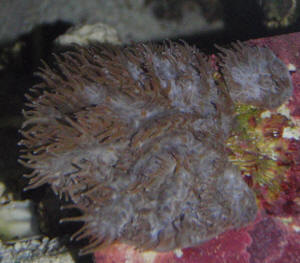 |
Re: Unidentifiable Coral --
11/09/2009
I apologize about the pic size!
I guess I forgot about that rule.
<Heeeee! We're fresh out of disk space!>
But do you have a good comparison picture?
<Mmm, I'll look>
I searched for Mussids and Symphyllia on Google images and got
nothing that looked like it.
<Mmm, no... just looked... All mine are large specimens, during
the day, with flesh retracted. BobF> |
|
LPS ID and phytoplankton product use
-- 10/26/09
Hi Grew,
I'm one more person, who would like to say how great and
informative your site.
<We share!>
I'm new in the hobby. My tank is 6 mo, however thanks to all
your advices, everything is doing well. I read your articles
almost every day.
I have a question regarding LPS ID. I found it in one local fish
store under name Neon Green. A salesman could not give me any
additional info. It covers a life rock, polyps a small about 3 mm
in diameter and 2-3 mm tall. They retract when disturbed. Is it
kind of Turbinaria?
<Mmm, need either better vision (no doubt actually) or a bit
larger, more-resolved image here, but I am pretty sure this is a
Goniopora (commonly called "Flowerpot") coral. Please
see here: http://wetwebmedia.com/gonioporapix.htm
and the linked files above re this genus' care>
And one more question. In most of your articles you mentioned
that corals eat zoo-plankton.
<Most all do to extents... along with no to some variable
amount of photosynthesis>
What kind of coral eat phytoplankton?
<... actually very few of what passes as "corals",
definitely not Scleractinians/Stonies consume much of any
phyto>
An instruction on bottles with phytoplankton says, that it is
food for filter feeders and corals.
<... A good point, statement... Most all such material is of
limited (to the extreme) use in hobbyist systems. The bulk is
taken out via skimming... Some soft coral groups (Alcyonaceans)
consume "some" species, sizes of phytoplankton... and
adding such products can lead indirectly to "better
conditions" in captive systems... but most of it is a
placebo>
Thank you for you time.
Igor
<And you for sharing. Bob Fenner>
|
 |
|
|

